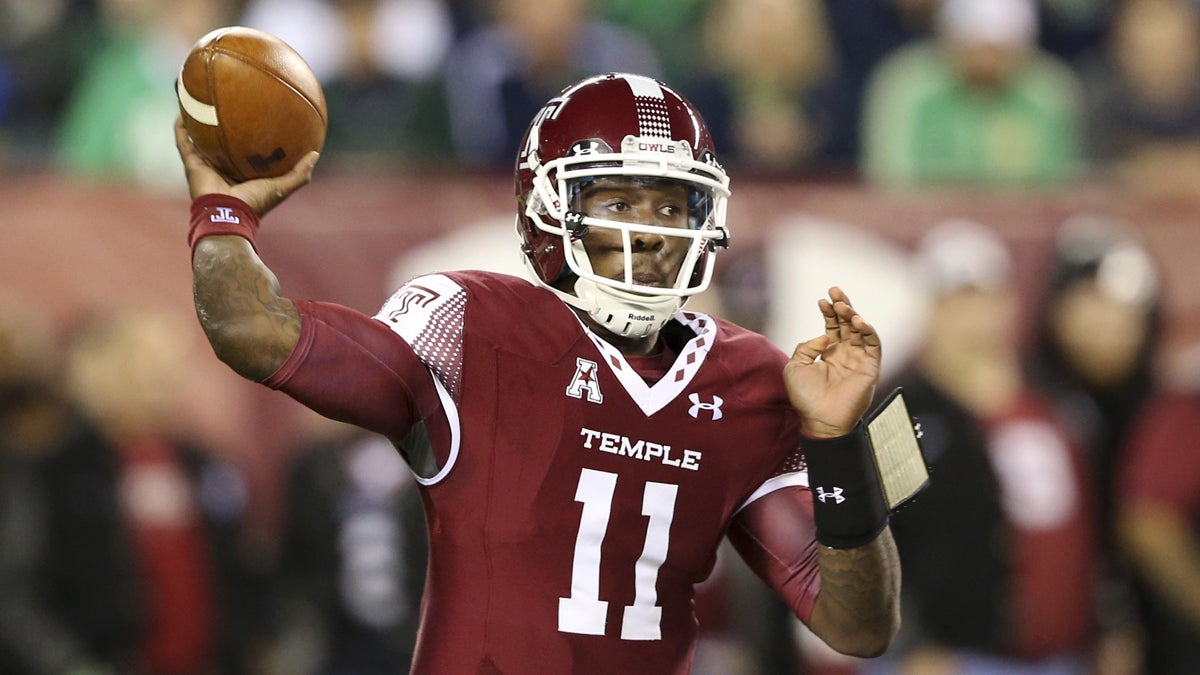Say ‘no’ to a Temple football stadium
The fact that Temple University wants to build an on-campus stadium is evidence that we have allowed the pendulum to swing too far from the origins of college athletics.

Temple quarterback P.J. Walker (11) throws a pass during an NCAA college football game against Notre Dame Saturday, Oct. 31, 2015, in Philadelphia. (AP Photo/Mel Evans)
The fact that Temple University is interested in building an on-campus football stadium is evidence to me that our society has allowed the pendulum to swing much too far from the origins of student athletics in our colleges.
It seems to me that there can be three possible purposes to college athletics:
- To enhance the college experience of the students by “rounding” them as people, promoting their long-term health, and letting them have some fun so as to return to their studies, renewed. [i.e., the original purpose.]
- To make a pile of money which can then be used for other purposes.
- To add spirit and prestige to the school.
As someone who, long ago, played intercollegiate soccer at a small school that not only didn’t recruit but didn’t even tell the soccer coach what he could expect in incoming freshmen from one year to the next, I can attest to the benefits of the former purpose. Physical training, making friends, and competition all serve to benefit the athletes for their lifetimes.
Sadly, in its pursuit of big-time football, Temple dropped seven intercollegiate sports — baseball, softball, men’s crew, women’s rowing, men’s gymnastics, and men’s track & field, both indoor and outdoor — which involved something like 150 athletes.
Unless football players are “more equal” than other student athletes, it’s clear that purpose No. 1 is not Temple’s objective. On the other hand, as a taxpayer in Pennsylvania, I’m all for purpose No. 2. So I’ve looked at it a little.
Show me the money
Online I found that Temple pays $265,000 per game to rent the Linc. Temple says their attendance last season averaged 23,370, though some feel that number may be inflated. If we accept it and if we assume $20 per ticket, they actually make about $200,000 per game. Of course that ignores the rest of the program costs.
Estimates are that Temple has to cover about $7 million of football program costs out of their general fund. That should come as no surprise. There is plenty to read out there about the non-profitability of college football. The NCAA claims that just over half of the FBS programs make money but, as with Temple’s attendance figures, they are not an unbiased source. Perhaps a more objective investigation was done by authors Jeff Benedict and Armen Keteyian in their book “The System: The Glory and Scandal of Big-Time College Football.” They state that, in the 2010-2011 academic year, only 22 of the 120 big-time schools made a profit on their football programs. They also made clear that the names on the list of profit-making schools don’t change significantly from year to year.
From what I’ve been able to learn, alumni giving changes very little as a school’s won-lost record varies from year to year. So Temple doesn’t stand to see much increase in giving because of this season, but won’t suffer much if they return to mediocrity.
The only way Temple’s program will reliably make money will be if they make that unheard-of jump into the top-20 group. If they don’t do that, the program will continue to be a drain on the school, and this stadium will only make it worse. If we assume six sellouts of 35,000 people at $25 a ticket, they take in $5.25 million, which might, just barely, cover the interest, but won’t pay off the principal. If they do make that jump, they will have joined the schools like PSU and Michigan, who have 100,000-plus stadiums. They will need to make that jump in the program happen quickly, so what will they then do with a 35,000-person stadium that’s only a few years old?
More likely, they won’t make the jump, and they will have a result similar to recent stadium-building projects at schools in similar situations, such as Akron, Central Florida, and others. Those projects have been financial disasters. Akron can’t fill their stadium even by letting students in for free. One could argue that Akron’s football program isn’t successful enough to draw them but, let’s be honest, were this any of the 40 years before this season, one would likely say the same of Temple’s program.
Given the above, I think it is safe to say that purpose 2 will not be served by this proposed new stadium.
Intangible prestige
Now, purpose, No. 3 is a tricky one. It is tough to measure “school spirit” or “prestige.” Perhaps there is some study somewhere that indicates that a big-time football program will so stimulate recruitment, both of athletes to sustain the program and of surefire-successful grads who will contribute much more money, as to change them. Maybe they can be a school that leverages athletic success to become a larger, more academically respected university. But even if that is the goal, how much is contributed to it by having an on-campus stadium rather using an NFL stadium (there’s gotta be some prestige there) that is a quick subway ride away? My answer: “Not much.”
So purpose No. 1 is not served; purpose No. 2 is a long-shot; and purpose No. 3 is unquantifiable and unlikely. Why do it?
As a state-funded school, Temple should be serving the interests of Philadelphia and Pennsylvania by producing graduates who contribute to our society. Even if this stadium were to contribute somehow to money, spirit and prestige, how does that translate into students who are better prepared to make a contribution in the world?
This stadium deserves a resounding “No!” from Philadelphia and from Harrisburg.
WHYY is your source for fact-based, in-depth journalism and information. As a nonprofit organization, we rely on financial support from readers like you. Please give today.



